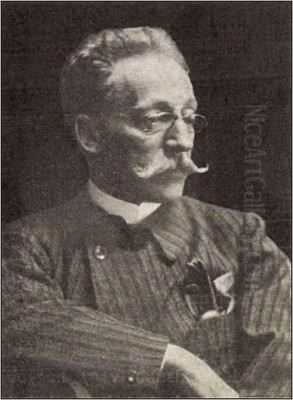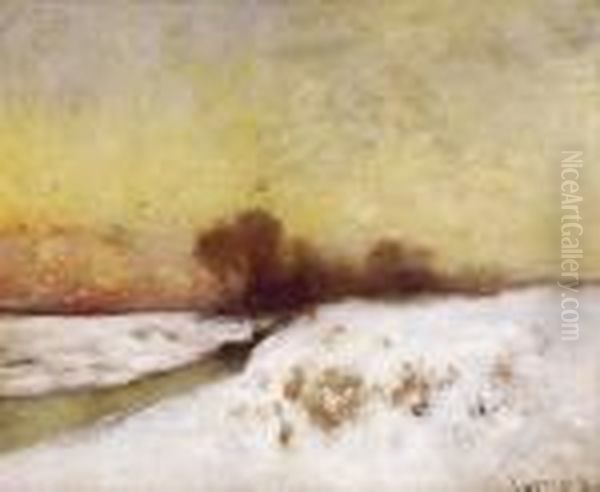
Béla Von Spányi (1852–1914) stands as a significant figure in Hungarian art history, renowned for his evocative landscape paintings that capture the unique atmosphere and soul of the Hungarian countryside. Working primarily in the late 19th and early 20th centuries, Spányi dedicated his artistic life to portraying the subtle beauties of his homeland, from the vast expanse of the Great Hungarian Plain (Alföld) to the intimate corners of its forests and riverbanks. His work reflects a deep connection with nature, rendered with a sensitivity to light and mood that continues to resonate with viewers today.
Early Life and Artistic Awakening
Born in Pest (now part of Budapest), Hungary, in 1852, Béla Von Spányi, or Spányi Béla as he is known in Hungarian, emerged during a period of burgeoning national identity and artistic development in Hungary. The Austro-Hungarian Compromise of 1867 had reshaped the political landscape, fostering a cultural environment where artists increasingly sought to define and express a distinct Hungarian character in their work. While specific details about his earliest artistic inclinations are not extensively documented, it is clear that his formative years were spent amidst this atmosphere of cultural searching.
His formal artistic training took him beyond the borders of Hungary, a common path for aspiring artists of his generation seeking to immerse themselves in the leading artistic currents of Europe. Spányi studied in several major art centers, which profoundly shaped his technical skills and aesthetic vision.
Academic Pursuits and Influences
Spányi's quest for artistic knowledge led him to Munich, a vibrant hub for art education in the 19th century. The Munich Academy was renowned for its rigorous training, emphasizing strong draftsmanship and a realistic approach to subject matter. Here, he would have been exposed to the teachings and works of influential figures like Karl von Piloty, known for his historical genre paintings, or perhaps Wilhelm von Kaulbach, though Spányi's path would lead him away from grand historical narratives towards the more intimate portrayal of nature.

He also spent time studying in Vienna, another imperial capital with a rich artistic tradition. The Vienna Academy of Fine Arts offered a different, perhaps more classical, perspective. These experiences in Germanic art centers provided him with a solid foundation in academic techniques. However, it was likely his time in Paris, the epicenter of artistic innovation, that introduced him to the revolutionary ideas of plein air painting and the Barbizon School.
The Barbizon School, with artists like Jean-Baptiste-Camille Corot, Théodore Rousseau, Jean-François Millet, and Charles-François Daubigny, had championed the practice of painting directly from nature, seeking to capture the transient effects of light and atmosphere. Their focus on rural landscapes and peasant life, rendered with a poetic realism, resonated deeply across Europe. Spányi absorbed these influences, adapting them to his own artistic temperament and the specific character of the Hungarian landscape. He was particularly drawn to the atmospheric qualities and melancholic moods often found in the works of Corot and Daubigny.
The Hungarian Landscape as Muse
Upon returning to Hungary, Spányi found his true calling in depicting the landscapes of his native land. He was not alone in this pursuit; contemporaries like Géza Mészöly and László Paál were also instrumental in establishing landscape painting as a significant genre in Hungarian art. Mészöly, in particular, is often seen as a kindred spirit, sharing Spányi's dedication to capturing the authentic feel of the Hungarian countryside. While Mihály Munkácsy, perhaps Hungary's most internationally famous painter of the era, also painted landscapes, his primary focus was often on dramatic genre scenes and figure compositions, though his powerful realism certainly contributed to the artistic climate.
Spányi developed a profound affinity for the Alföld, the Great Hungarian Plain. This vast, flat expanse, with its distinctive flora, wide skies, and often solitary atmosphere, became a recurring subject in his work. He was adept at capturing the subtle shifts in light across these plains, the hazy mornings, the golden glow of late afternoons, and the melancholic beauty of twilight. His paintings often evoke a sense of quietude and introspection, reflecting a deep, personal connection to these scenes.
His subjects were not limited to the plains. Spányi also painted forest interiors, riverbanks, village outskirts, and scenes of rural life, always with an eye for the specific atmospheric conditions. He was a master of depicting the changing seasons, from the crisp air of autumn and the starkness of winter snow to the gentle awakening of spring and the lushness of summer.
Artistic Style and Techniques
Béla Von Spányi's style is generally characterized as a form of atmospheric Realism, deeply influenced by the principles of plein air painting. He sought to convey not just the visual appearance of a landscape but also its emotional resonance. His brushwork, while controlled, often had a softness that contributed to the hazy, atmospheric effects he achieved. His palette was typically subdued, favoring earthy tones, muted greens, and subtle greys and blues, which perfectly captured the often melancholic and gentle light of the Hungarian landscape.
He paid meticulous attention to the nuances of light and shadow, understanding their power to define form and create mood. Whether depicting the diffused light of an overcast day or the dramatic contrasts of a setting sun, Spányi's handling of light was a key element of his artistry. This focus on atmosphere links him to the broader European trend of "mood landscape" painting prevalent in the late 19th century, seen in the works of artists from various national schools, such as the Russian landscape painters Ivan Shishkin or Isaac Levitan, who similarly sought to capture the soul of their native lands.
While he embraced realism, it was not a stark, photographic realism. Instead, his work is imbued with a lyrical quality, a gentle poetry that elevates the ordinary scenes he depicted. This poetic sensibility distinguishes his work and gives it an enduring appeal. He was less concerned with dramatic, picturesque views and more interested in the quiet, unassuming beauty of everyday nature.
Representative Works
Identifying specific, universally acclaimed "masterpieces" for every artist can be challenging, especially for those whose fame is more national than global. However, several paintings by Béla Von Spányi are frequently cited as characteristic of his style and thematic concerns.
Works such as "Őszi erdő" (Autumn Forest) showcase his ability to capture the rich, yet melancholic, colors of autumn and the intricate play of light filtering through the trees. "Olvadás" (Thawing) or "Tavaszodik" (Spring is Coming) would demonstrate his sensitivity to the subtle signs of seasonal change, the melting snow revealing the earth beneath, and the promise of new life.
Paintings titled "Erdőszéle" (Edge of the Forest) or "Folyópart" (Riverbank) are common themes, allowing him to explore the interplay between different natural elements – trees, water, sky – and the varied textures of the landscape. "Pásztortűz" (Shepherd's Fire) or similar scenes depicting solitary figures or simple rural activities within the vast landscape would highlight his connection to the human presence within nature, often emphasizing a sense of harmony or quiet endurance.
Many of his works are simply titled with descriptive phrases like "Landscape with Trees," "Winter Landscape," or "Sunset on the Plain." These titles reflect his direct engagement with the subject matter, allowing the visual power of the painting itself to convey its meaning and emotion. The cumulative effect of his oeuvre is a comprehensive and deeply felt portrait of the Hungarian landscape in all its varied moods and seasons.
Exhibitions, Recognition, and Later Career
Béla Von Spányi was an active participant in the Hungarian art scene. He regularly exhibited his works at the National Salon (Nemzeti Szalon) and other art venues in Budapest. His paintings were generally well-received for their sincerity and technical skill. While he may not have achieved the same level of international fame as some of his contemporaries, like Munkácsy, he earned a respected place within Hungarian art.
His dedication to landscape painting contributed significantly to its development and appreciation in Hungary. He, along with artists like Mészöly and Paál, helped to establish a strong tradition of plein air landscape painting that would influence subsequent generations of Hungarian artists. One can imagine him interacting with other prominent Hungarian artists of the time, perhaps Károly Lotz, known for his monumental frescoes but also a skilled painter, or Bertalan Székely, another leading figure in Hungarian Romantic and historical painting who also produced landscapes.
Throughout his career, Spányi remained committed to his artistic vision. He continued to explore the Hungarian landscape, refining his ability to capture its elusive atmospheric qualities. There are no records of dramatic shifts in his style; rather, his development was characterized by a deepening of his understanding and a consistent refinement of his chosen path.
Anecdotes about his personal life or specific working habits are not widely circulated in English-language sources, which is common for many artists whose primary recognition is within their national context. However, his body of work speaks volumes about his dedication, his patient observation of nature, and his profound love for the Hungarian countryside. One can envision him, like the Barbizon painters he admired, setting up his easel in the open air, enduring the elements to capture a fleeting moment of light or a particular mood. This dedication to direct observation was a hallmark of his practice.
Legacy and Place in Art History
Béla Von Spányi passed away in Budapest in 1914, on the cusp of the First World War, an event that would irrevocably change the European landscape he so lovingly depicted. His legacy lies in his extensive body of work, which provides a rich and nuanced portrayal of Hungary at the turn of the 20th century. His paintings are held in the collections of the Hungarian National Gallery and other museums in Hungary, as well as in private collections.
He is remembered as a key figure in the tradition of Hungarian landscape painting, an artist who successfully blended academic training with the innovative approaches of plein air realism. His work stands as a testament to the beauty of the Hungarian landscape and the enduring power of art to capture the spirit of a place. He can be seen as part of a broader European movement where artists sought to find national identity and universal beauty in their local environments, a sentiment shared by artists like Gustave Courbet in France with his rugged Realism, or the aforementioned Russian landscape painters.
His contribution was not one of radical innovation in the vein of the Impressionists or Post-Impressionists who were his contemporaries in Paris, such as Claude Monet or Vincent van Gogh. Instead, Spányi's strength lay in his consistent and sensitive interpretation of his chosen subject matter, creating a body of work that is both historically significant and aesthetically pleasing. He provided a Hungarian voice to the wider European conversation about landscape painting and realism.
Conclusion: The Enduring Atmosphere of Spányi's Hungary
Béla Von Spányi's art offers a window into the soul of the Hungarian landscape as it was perceived and felt by an artist deeply attuned to its nuances. His paintings are more than mere topographical records; they are poetic evocations of mood, light, and atmosphere. Through his dedicated practice, he captured the quiet majesty of the Alföld, the intimate charm of forests and riverbanks, and the subtle transformations of the seasons.
His commitment to atmospheric realism, influenced by the Barbizon School yet distinctly Hungarian in its sensibility, secured him a lasting place in his nation's art history. While the world has changed dramatically since his time, the timeless beauty and quiet contemplation found in Béla Von Spányi's landscapes continue to offer solace and inspiration, reminding us of the profound connection between art, nature, and national identity. His work remains a cherished part of Hungary's cultural heritage, a visual ode to the enduring allure of its natural world.